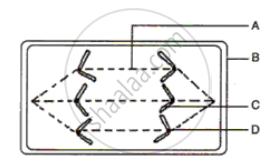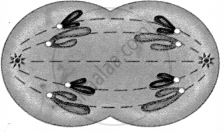Advertisements
Advertisements
प्रश्न
With the help of suitable diagrams, explain the five stages of prophase-I of meiosis.
उत्तर
Prophase I is the longest phase of meiosis and is further sub divided into 5 phases:
- Leptotene

Condensation makes chromosomes become distinct and compact. - Zygotene

Homologous chromosomes start pairing together by a process called synapsis to form a complex structure called synaptonemal complex. Two synapsed homologous chromosomes form a complex called bivalent or tetrad. - Pachytene

Longest phase of prophase I
Recombination nodules appear in this stage at the sites where crossing over has to take place between non-sister chromatids of homologous chromosomes. - Diplotene

Synaptonemal complex dissolves and recombinants separate from each other except at crossover sites to form X-shaped structure called chiasmata. - Diakinesis

Chiasmata terminalises and chromosomes condense. Meiotic spindle assembles and nucleolus and nuclear envelope disappear.
APPEARS IN
संबंधित प्रश्न
Fill in the blank and explain the statement.
All chromosomes are arranged parallel to equatorial plane of cell in ______ phase of mitosis.
Fill in the blank:
______ is the indirect cell division.
The diagram given alongside represents a stage in cell division.
Study the same and answer the questions that follow:

(i) Identify the stage of cell division.
(ii) Name the parts labeled A,B,C and D.
(iii) What is the unique feature observed in this stage?
(iv) Where does this type of cell division usually occur?
(v) How many daughter cells are formed from this type of cell division?
(vi) Is the dividing cell shown a plant or an animal cell?
Give a reason to support your answer.
Choose the correct answer:
Which division takes most time?
Explain the Term Pachytene
Name the following:
Replacement of dead cells is accomplished by which process.
Name the Following
Name the stage during which nuclear membrane and nucleoli reappear.
Give Technical Terms
The stage in mitosis when the nucleolus starts disappearing.
Give Technical Terms
Division of nucleus.
Multiple Choice Question:
Karyokinesis is the division of
Multiple Choice Question:
The nuclear membrane disappears in
Column ‘II’ is a list of items related to ideas in Column ‘I’. Match the terms in Column ‘II’ with a suitable idea given in Column ‘I’.
| Column I | Column II |
| (i) Anaphase | (a) Chromosomes become arranged in a horizontal plane at the equator. |
| (ii) Prophase | (b) Daughter chromosomes move to opposite poles of the spindle. |
| (iii) Telophase | (c) Chromosomes become visible as fine, long threads. |
| (iv) Metaphase | (d) Chromosomes lose their distinctiveness and gradually become transformed into chromatin network. |
Explain the following figure.

Identify the stage of mitosis from the below picture. List the chromosomal events in this stage.

Name these:
Two steps of the process Mitosis
